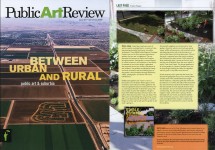Essay for Public Art Review, page 98 Issue 39, Fall-Winter 2008 {jpeg} [PDF]
Since 2005 I have been creating a series of public projects on private land in a variety of cities, repurposing domestic front lawns into edible landscapes. These Edible Estate Regional Prototype Gardens are not the fussy precious aspirational gardens that you see in magazines. They are examples that anyone can look at and imagine doing themselves. Each garden is commissioned by a local museum or art institution, a local family is selected as host, and a design is generated that responds to the site, climate, and desires of the residents. The gardens are planted by friends and local volunteers, and the unfolding story of the garden is then broadcast through exhibitions, videos, photographs, and stories with many collaborators.
Edible Estate gardens are meant to serve as provocations on the street. What happens when we share a street with one of these gardens? The front-yard gardeners become street performers for us. Coming out the door to tend their crops they enact a daily ritual for the neighbors. We get to know them better than those who have lawns. We talk to them about how their crops are doing. They often can’t eat everything they are growing, so they offer us the latest harvest of tomatoes or zucchini. We go out of our way to walk past the garden to see what is going on.
Occasionally neighbors are threatened by these gardens. Anarchy, rodents, plummeting property values, willful self-expression, wild untamed nature, ugly decaying plants, and winter dormancy are some of the reasons that have been given. More to the point is a general sense that some unspoken law of decency has been broken. Public tastes still favor conformity when it comes to the front yard, and any sort of deviation from the norm signals a social, if not moral, lapse. The abrupt appearance of such a garden on a street of endless lawns can be surprisingly shocking, but after the neighbors watch it grow in, they often come around.
Private property and in particular the home has become the geographic focus of our society. When we take stock of the standard American single-family residence, it becomes quite clear where the priorities are. It is within the walls of the house that the real investment and life of the residents occur. The land outside the walls typically receives much less attention, and can even become downright unwelcoming. Any activity in the yard will typically happen in back, where there is privacy. We are obsessed with our homes as protective bubbles from the realities around us. Today’s towns and cities are engineered for isolation, and growing food in your front yard becomes a way to subvert this tendency.
– Fritz Haeg, 2008
